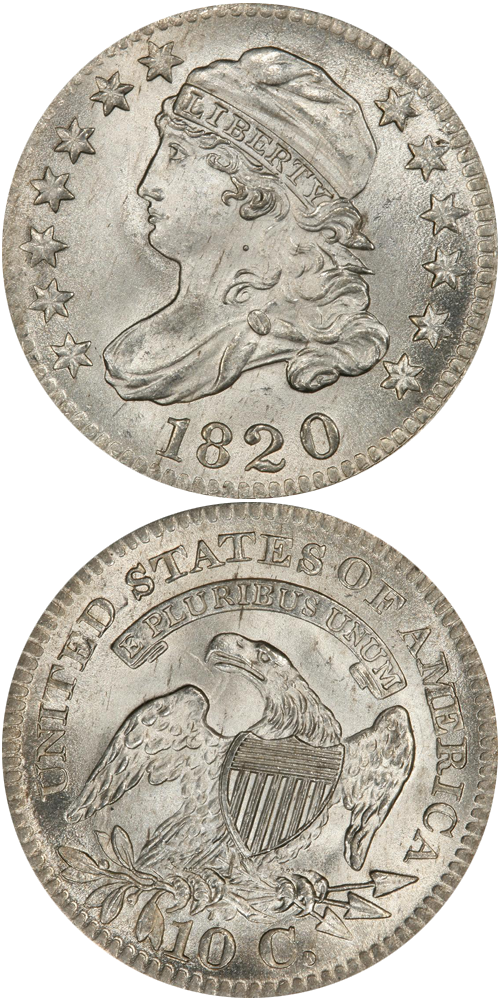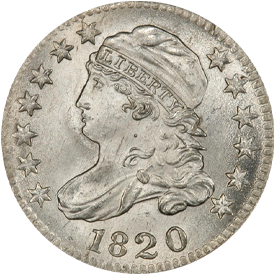Designed by: John Reich
Issue Dates: 1809-1827
Composition: 89.24% silver, 10.76% copper
Diameter: 18.8 mm (with some variation)
Weight: 2.69 grams (41.51 grains)
Edge: Reeded
Business Strike Mintage: 4,931,844
In 1809 the Capped Bust dime made its appearance. The design is similar to that used on earlier half dollars beginning in 1807. The obverse features Miss Liberty with her hair in a cloth cap secured by a band inscribed LIBERTY, with tresses flowing down to her shoulder. Her bust is draped in a cloth or gown secured by a clasp or brooch. Seven stars are to the left and six to the right. The date is below. The reverse depicts an eagle perched on a branch and holding arrows, E PLURIBUS UNUM is on a scroll above, and UNITED STATES OF AMERICA and 10 C. appear around the border. The planchet diameter is approximately 18.8 mm, which distinguishes it from the small planchet (approximately 17.9 mm) format, struck in a closed collar, introduced in 1828.
Coinage during the 1809-1827 years was intermittent; some years were skipped. Specimens of commoner dates are readily encountered in various grades from Good to Very Fine. Extremely Fine pieces can be found without difficulty, as can AU coins. Uncirculated pieces, particularly finer examples of these, are quite rare. Striking is apt to vary from issue to issue, and finding one with excellent definition of detail will not be easy.
Further Reading
The availability of dimes in the 1809-1827 range varies with the date. In general, those with higher mintages tend to be more common than those with lower mintages, but among higher echelon grades such as Uncirculated, such rules do not hold fast. Dimes of 1809, the first year of the Capped Bust style, are fairly elusive in all conditions, but in Uncirculated state the issue is very rare.
Dimes of 1811 are seen with greater frequency in all grades, with Uncirculated pieces being elusive, but not to the degree of those dated 1809. All 1811 dimes are 1811/09 overdates.
It is not until the third year of dime production of this type, 1814, that issues are less than scarce or rare. 1814 dimes are readily available in all grades from About Good through Extremely Fine, and even AU and Uncirculated coins appear on the market with some frequency.
Likewise, the next following issue, 1820, is readily available in different grades across the board, although among the 13 individual die varieties known to scholars, some are decidedly rare.
Dimes of 1821, which exist in at least 10 die variety combinations, are available in all grades, although Uncirculated pieces are apt to be difficult to track down, particularly in view of the demand for them by type set collectors.
Dimes of the next year, 1822, are scarce in all grades and are one of the most desired dates among issues of the 1809-1837 type. Among the population of several hundred known pieces, the majority are in lower grades, although enough Very Fine and Extremely Fine pieces exist that the specialist, with some diligence, can locate one. Uncirculated coins are a different story and are apt to come to light only when great collections are sold. From time to time this particular date has attracted the fancy of investors and speculators, and a few scattered hoards cross the screen of numismatic history, with a cache of 17 coins sold by Paramount International Coin Corporation in the 1970s being particularly notable.
Dimes of 1823 are all overdates, 1823/2. Two obverse dies and two reverse dies were combined in the sequence 1-A, 1-B, and 2-B to create a total of three die varieties for the year. The reverse dies are commonly differentiated by having either small E's (Reverse A) in the legend or large E's (Reverse B). These particular issues are listed in A Guide Book of United States Coins, but it is my opinion that prob ably not one in 10,000 readers of that popular reference book could care a whit about letter sizes on dimes of this year. 1823/2 dimes are readily available in all grades below Uncirculated condition, with the latter grade being obtainable with some persistence.
The 1824 dimes are likewise overdates, in this instance 1824/2. Just one obverse die was used to strike pieces dated this year. Two reverse dies were used, Reverse A being quite common and Reverse B (distinguished by having the letters ERI in AMERICA joined together at the bases) being very rare. Few dealers catalogue dimes by die varieties, as there is relatively little call for them, resulting in a fortunate situation for the die variety specialist. There is a good chance that intense searching by the specialist will unearth an 1824/2 dime with Reverse B-at a price no more than one would pay for the more often seen Reverse A issue.
Of dimes dated 1825, five different die combinations are known, two of which are fairly rare. As is the case with other dimes in this date range, until collecting dimes by minute die varieties becomes popular (if it ever does), the specialist can have a field day searching for and finding rare die combinations priced at no more than common issues.
In 1827, dimes were produced in abundance, with a recorded mintage of over a million pieces, divided into at least 13 known die varieties. As a date, specimens are readily available in all grades, although Uncirculated pieces are fairly elusive due to the demand on the part of type collectors. Certain die varieties of the year are scarce, however.








